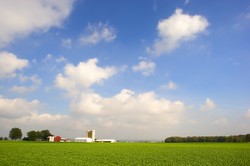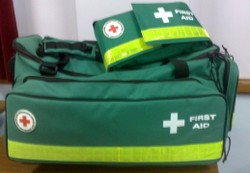One of my friends was talking about a farming problem he had, and it showed some of the difficulties farmers have. Let's make up our own example.
First think of a farm. Think of a location and type of farm.
Then think of a problem that farm may have.
Then use the internet to benchmark the best practice for solving this problem.
~~~
Sounds easy enough.
Here is what happened when I tried it.
Friend is a South Australian sheep farmer.
The problem was stopping sheep getting bogged in the muddy sides of dams as water evaporates.
My friend digs them out by hand, risking getting kicked, drowned and bogged himself.
Is this best practice?
It is for my friend, he doesn't have time he says, he scouts the dams out on a motorbike with his sheepdog and does the jobs as they need doing.
~~~
So I went looking on the internet.
First I looked for "farming safety south australia", top hit was a link from Farmsafe.
Here...
http://www.farmsafe.org.au/index.php?article=content/partnerships
Except the link for South Australia doesn't work...
I couldn't put it in this document as this system won't allow dead links to be posted, it's on the list in the first link.
Farmsafe is affiliated with a political party called the National Farmers Federation, but that doesn't mean anything to me. Safety is apolitical.
However the link should work. If a farmer is trying this for the first time, it may well be the last time if they hit a dead link.
From there I tried various "sheep bogged" searches. With no luck. I wanted to find a best practice method of retrieving sheep or preventing sheep from bogging.
~~~
Try this exercise as just described.
I'm of the opinion that the internet is not well rigged to give farmers access to best practice farming methods.
There are plenty of generic safety advice sites that detail legislation and regulation, but not heavy on specifics. There is nothing wrong with these sites, and the people there do want to help, but greater help would be provided if it was more specific. And two-way, so that farmers could help each other easily.
Here is one example of such a site...
http://www.sa.gov.au/subject/Business,+industry+and+trade/Employing+people/Work+health+and+safety/Farm+workplace+safety
And given how farmers are desperately outgunned in the information department we need to address this lack of help from the internet, which is perfectly placed to provide fast information to a farmer out by herself.














 We are always wrongon 12/12/2014
We are always wrongon 12/12/2014
 Conspiracies are Realon 03/24/2014
Conspiracies are Realon 03/24/2014
 Workout for the Doleon 02/26/2014
Workout for the Doleon 02/26/2014
 Fiery New Brands for Aussie politicson 02/25/2014
Fiery New Brands for Aussie politicson 02/25/2014


Comments